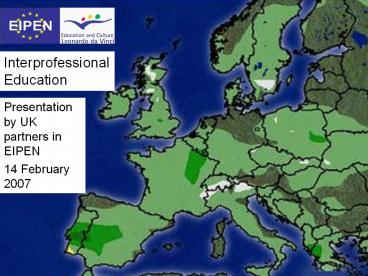Interprofessional%20Education%20in%20the%20UK
Title:
Interprofessional%20Education%20in%20the%20UK
Description:
... teaching is important Dr Margaret Sills, Director of EIPEN (Higher Education ... research into experiences of UK Higher Education educators in the UK ... –
Number of Views:55
Avg rating:3.0/5.0
Title: Interprofessional%20Education%20in%20the%20UK
1
Interprofessional Education
Presentation by UK partners in EIPEN 14 February
2007
2
Contributors
- Why interprofessional learning and teaching is
important Dr Margaret Sills, Director of EIPEN
(Higher Education Academy Subject Centre for
Health Sciences and Practice - Trends in the development of IPE
Professor Hugh Barr, President of the Centre
for the Advancement of Interprofessional
Education - Effective teaching for interprofessional learning
Dr Marion Helme, EIPEN Project Manager,
Higher Education Academy - Social work and interprofessional education Dr
Anne Quinney, Academic Adviser, Social Policy and
Social Work Subject Centre - The way forward sustaining interprofessional
education Lisa Hughes, Director of Creating an
Interprofessional Workforce - Summary Professor Hugh Barr
3
Why Interprofessional Learning and Teaching has
developed in the UK
- To minimise mistakes and failures in care
- To improve communication between professions
- To improve communication with patients, clients
and service users - To maximise health and well-being
- Additional positives in development of
interprofessional learning - Student engagement, debate and interactive
processes of learning, - Teacher engagement and interest
- Interdisciplinary user and carer involvement
- Helps to shift from expert-centred care to
person centred care - Some challenges and problems
- Terminology interprofessional
/multiprofessional/shared learning - Hierarchies between health professions
- Separation between different university
disciplines and departments - Pedagogic complexity
- Evaluating the outcomes does IPE change
practice?
4
Trends in interprofessional learning and
teaching From To
- One-off --- Long-term
- Discrete --- Integrated
- Marginal --- Mainstream
- Bottom up --- Top down
- Shorter ---- Longer
- Later --- Sooner
- Didactic --- Interactive
- Common --- Comparative
- Pragmatic ---Theoretical
- Faith-based --- Evidence-based
- Single-purpose --- Multi-purpose
- Local--- National--- International
5
Teaching for interprofessional learningfrom
TRIPLE Project research into experiences of UK
Higher Education educators in the UK
- What works
- Well-prepared and skilled teachers
- Mutual respect between learners
- The right time for students
- Strong connection between IPE and the rest of the
curriculum - Knowing that students and teachers have a
professional bias - Teachers who are fire-stokers enthusiastic
about IPE - The involvement of patients or simulated
patients. IPE needs an idea that matters to
people.
- What does NOT work
- Poorly constructed learning opportunities
- Domination by one profession or gender in the
student group - Uni-professional teaching for interprofessional
learning - Reinforcing stereotypes by not challenging
disparaging behaviour - IPE not integrated with rest of curriculum and
assessment - Classroom IP learning without exposure to
patients, clients, service users and carers.
6
Social Work and Interprofessional Education
- Informed by the modernisation agenda for public
services (DH 1998), the policy documents which
are the compulsory foundations of the social work
degree (DH 2002 QAA 2000 TOPSS 2002 GSCC 2002)
refer to requirements for interdisciplinary,
interprofessional, interagency and partnership
working to form part of the curriculum. - This learning is undertaken in agency settings as
well as, and instead of, interprofessional
education opportunities in the university-based
aspects of the curriculum. - This collaborative practice does not only include
working with colleagues in health settings but
also in the fields of education, youth work,
housing, state benefits and justice. It also
includes working in partnership with service
users and carers (see Quinney 2006).
7
The way forward sustaining IPECIPW 2004-2007
- Time to plan, deliver and facilitate IPE
- Developing, recognising and rewarding
collaborative culture in service organisations - Champions to promote IPE
- IPE is mandatory within educational curricula
- Agreed criteria for success and quality
- IPE is patient/service user-centred
- Parity of training and education across health
and social care - Effective commissioning of education by health
and social care services - IPE embedded in service delivery
8
Summary key elements
Service Improvement
Team Development
Community Development
9
interconnected







![[PDF] Primary Care: Interprofessional Collaborative Practice Kindle](https://s3.amazonaws.com/images.powershow.com/10087326.th0.jpg?_=20240727088)





![[PDF] Study Guide for Medical-Surgical Nursing: Concepts for Interprofessional Collaborative Care 10th Edition Full](https://s3.amazonaws.com/images.powershow.com/10101179.th0.jpg?_=20240816105)

















